The Streak…
I am feeling lousy today. That is a a huge improvement from yesterday….
Congrats to Peyton Manning and the Broncos and to Richard Sherman and the Seahawks for advancing to the Super Bowl.
This post inexplicably marks 55 days in a row with a new educational blog post, a record by far that should be extended for at least another week or two. Or not. 🙂 To show your appreciation, we ask that use our B&H and Amazon affiliate links for all of your B&H and Amazon purchases. Please check the availability of all photographic accessories in the BIRDS AS ART Online Store. We sell only what I use and depend on. We will not sell you junk. We know what you need to make creating great images easy and fun. And we are always glad to answer your gear questions via e-mail.
You can find the following items in the store: Gitzo tripods, Mongoose M3.6 and Wimberley heads, plates, low feet, and accessories, flash brackets, , Delkin e-film Pro Compact Flash Cards, LensCoat products, and our unique line-up of educational materials including ABP I & II, Digital Basics, Site and Set-up e-Guides, Canon and Nikon Camera Users and AF e-Guides, and MP-4 Photoshop video tutorials among others.
We would of course appreciate you using our B&H and Amazon affiliate links for all of your B&H and Amazon major gear, video, electronic, household, and personal purchases. For the photographic stuff mentioned above we would of course great appreciate your business.
Thanks and enjoy today’s blog post! More than 3 1/2 hours of work went into the creation of this blog post 🙂
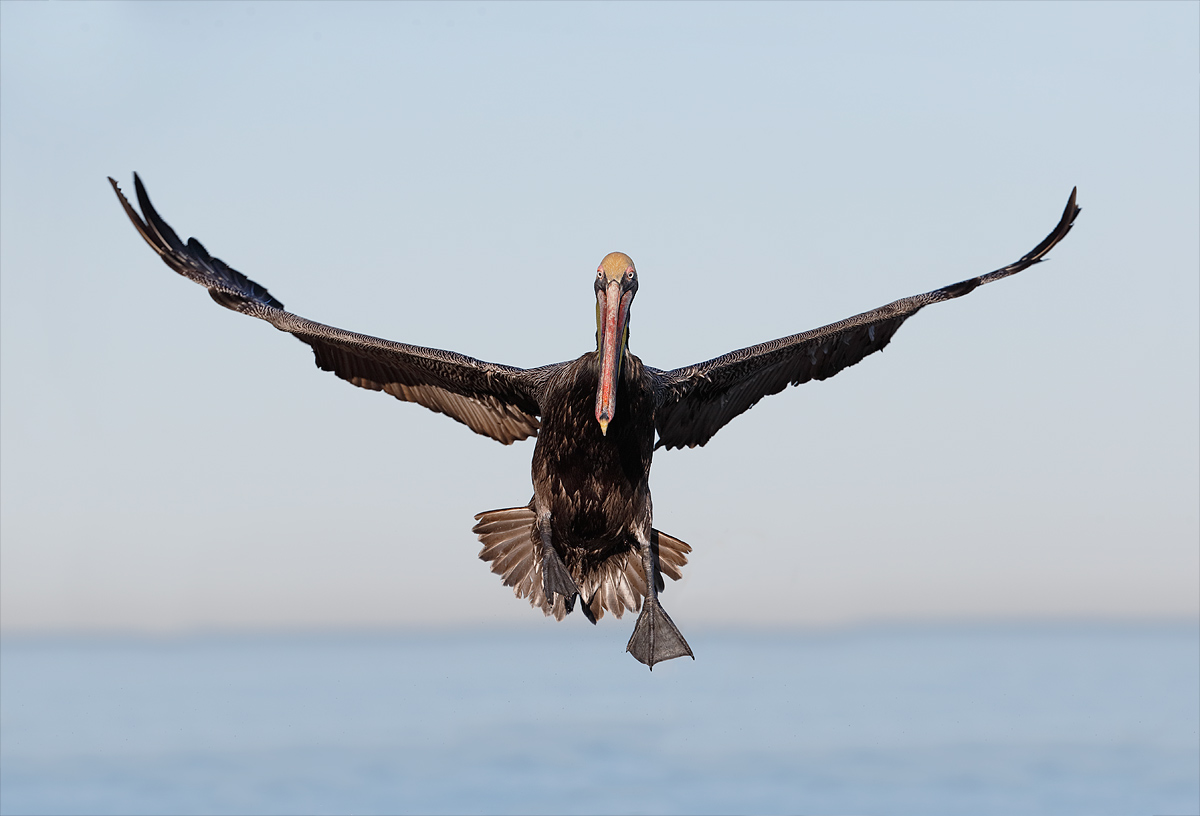
|
|
This landing Brown Pelican image was created with the Canon EF 300mm f/2.8L IS II USM lens and the Canon EOS-1D X. ISO 400. Evaluative metering +1/3 stop: 1/? sec. at f/? Manual mode. Central Sensor/AI Servo–Rear Focus AF on the top of the bird’s head active at the moment of exposure. Click here to see the latest version of the Rear Focus Tutorial. Click on the image to see a larger version.
|
300 f/2.8 for Flight Photography and More
After letting folks know why I feel that the 200-400 is a superior lens for bird and wildlife photography in yesterday’s blog post here, I wanted to give a shout out to the 300mm f.2l8L IS lens…. FYI: I have responded to the many interesting questions and comments in the “300 f/2.8L IS or 200-400 f/4L IS with Internal TC/Which is the best lens?” post; it is well worth a re-visit.
As you can see above, it can be a great lens for hand held flight photography. The key is to be able to estimate that size of the subject in the frame and position yourself to create images the birds filling 2/3 to 3/4 of the frame. On our San Diego trip, we were somewhat cursed with still mornings; when the winds are light the birds come in low and we often wound up with the heads of various pelicans in the bottom of the frame as in the image above.
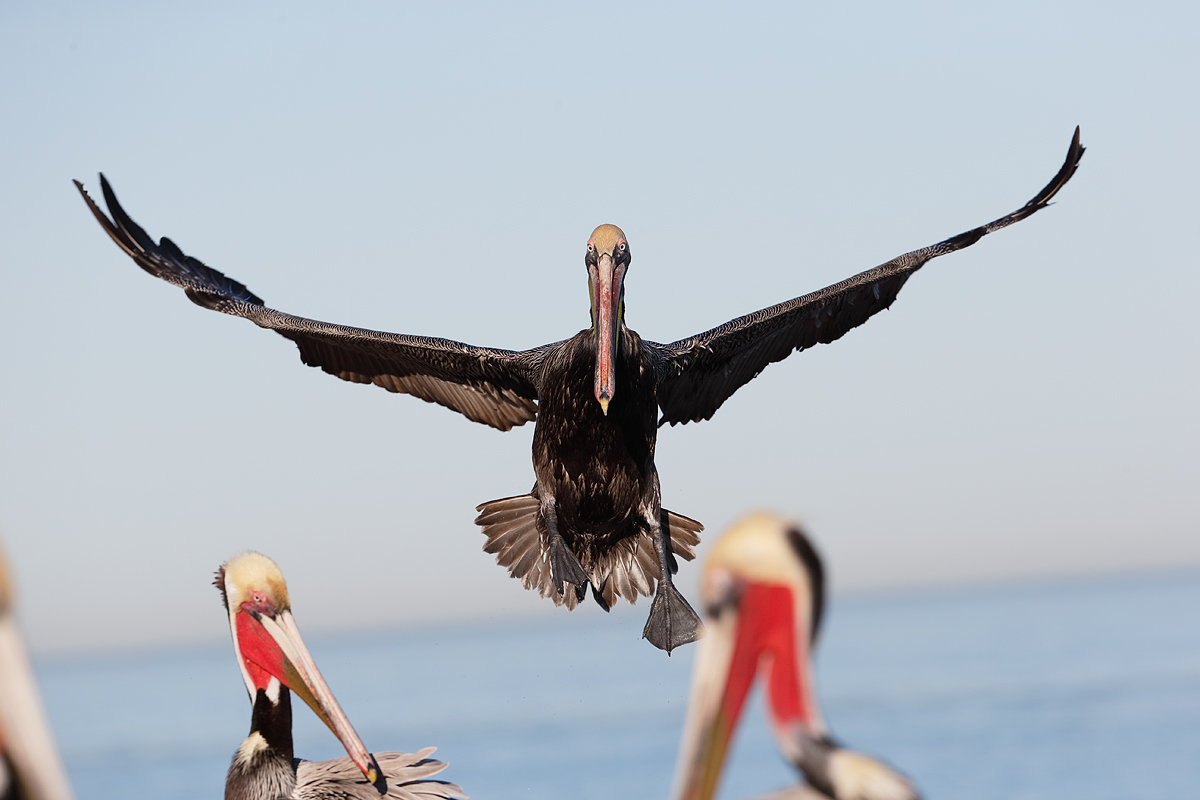
|
|
This is the original image. |
The Image Optimization
The image optimization was fairly straight-forward, except for the missing part of the bird’s left foot that had merged with one of the pelican heads…. After leveling the image, I used the flopping technique from APTATS II along with a Hide-All Layer Mask to cover the offending pelican heads and followed that up with some 80% opacity Clone Stamp Tool work. Advanced Quick Masking Techniques are detailed in APTATS I. Mention this blog post and Jim will be glad to apply a $5 discount on your APTATS I purchase with phone orders only. The flopping technique is one of several tutorials detailed in APTATS II. Mention this blog post and Jim will be glad to apply a $10 discount on your APTATS II purchase with phone orders only. Order both to hone your Photoshop image clean-up skills and Jim will be glad to enter a $15 discount for the pair, on phone orders only.
Everything else and tons more is detailed in Digital Basics File, an instructional PDF that is sent via e-mail. It includes my complete digital workflow, dozens of great Photoshop tips, several different ways to expand canvas, all of my time-saving Keyboard Shortcuts, Quick Masking, Layer Masking, and NIK Color Efex Pro basics, my killer image clean-up techniques, Digital Eye Doctor, and tons more.
The Image Optimization Question…
How did I re-construct the missing part of the bird’s left webbed foot? There were several steps in involved; please be specific. On a related note, how would you have attempted the repair?
|
This Steller’s Sea Eagle image was created with the hand held Canon 300mm f/2.8 L IS II lens, 1.4X III TC, and the Canon EOS-1D Mark IV (now replaced by the Canon EOS-1D X). ISO 800. Evaluative metering +2 1/3 stops off the white sky: 1/640 sec. at f/4 in Manual mode. Central sensor/AI Servo Rear Focus AF on the bird’s upper breast active at the moment of exposure. Click here if you missed the Rear Focus Tutorial. Click on the image to enlarge it. |
Japan
I first used the 300 II on my February 2012 Japan trip, most often for flight photography of Steller’s Sea Eagles from the tourist boat and also at one of the two crane parks where the Red-crowned Cranes often flew by at close range. With the 1.4X III TC it proved to be a deadly combination.
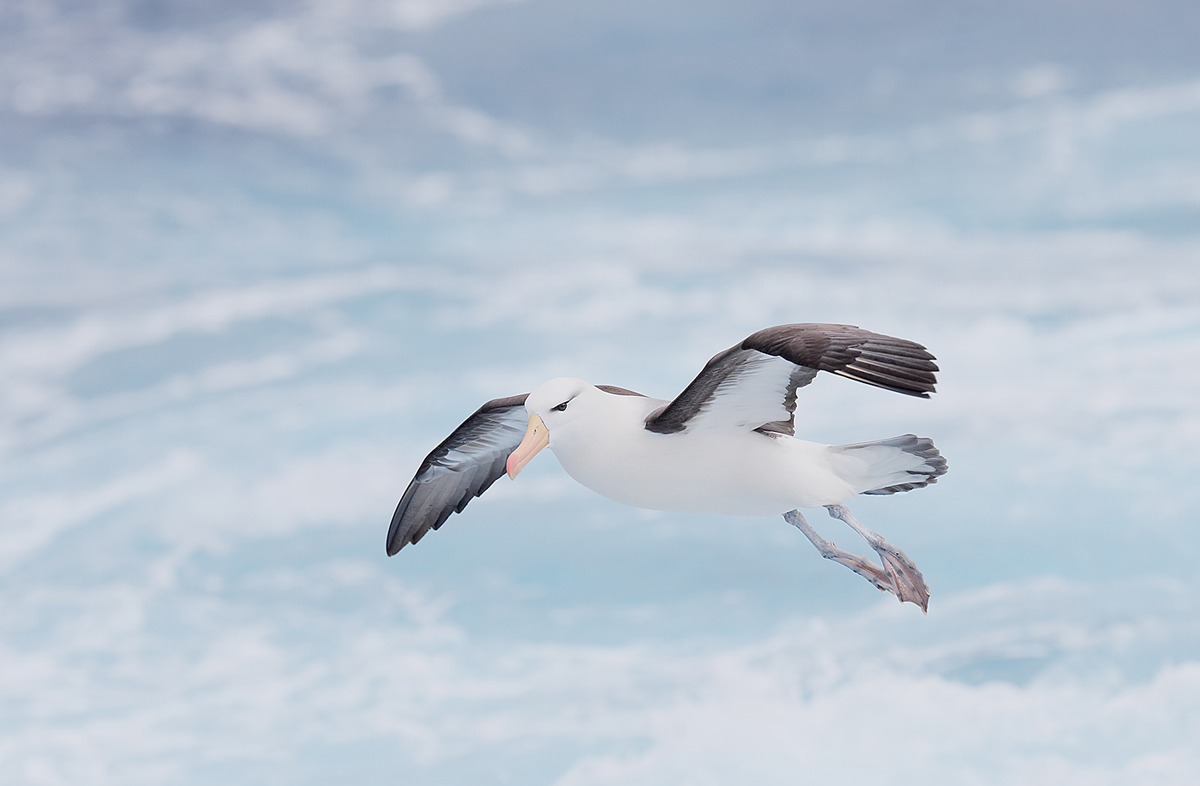
|
|
This Black-browed Albatross image was created with the hand held Canon 300mm f/2.8 L IS II lens, 1.4X III TC, and the Canon EOS-1D X. ISO 800. Evaluative metering +1 stop: as framed: 1/2000 sec. at f/6.3 Central sensor/AI Servo Rear Focus AF on the bird’s face active at the moment of exposure. Click here to see the latest version of the Rear Focus Tutorial. Click on the image to see a larger version. |
The Southern Oceans Trips
On my two 2012 Southern Oceans trips, the 300 II proved to be an extremely valuable asset. With the tame birds it was–on the longer walks–the longest lens that I took ashore. Alone or with either Series III TCs it routinely produced razor sharp images. I tried to work on a tripod whenever I used the 2X. On my second trip that year I wrecked my brand new 500 f/4L IS II; the 300 II served as a more than adequate back-up.
|
This abstract King Penguin neck pattern image was created at St. Andrews Bay with the Gitzo 3532 LS carbon fiber tripod, Mongoose M3.6 head, the Canon EF 300mm f/2.8L IS II USM Telephoto Lens, the Canon 2x EF Extender III (Teleconverter), and the discontinued EOS-1D Mark IV (now replaced by the Canon EOS-1D X). ISO 400. Evaluative metering +1 2/3 stops: 1/125 sec. at f/16 in Manual mode. Central sensor/AI Servo Rear Focus AF and recompose. Click here if you missed the Rear Focus Tutorial. Be sure to click on the image to enjoy a larger version. |
Nature’s Best Honored Image
The image above was honored in the Art in Nature category–I love when they name contest categories after me–of the Windland Smith Rice International Photography competetion. Thanks to Denise Ippolito for suggesting that I enter this one.
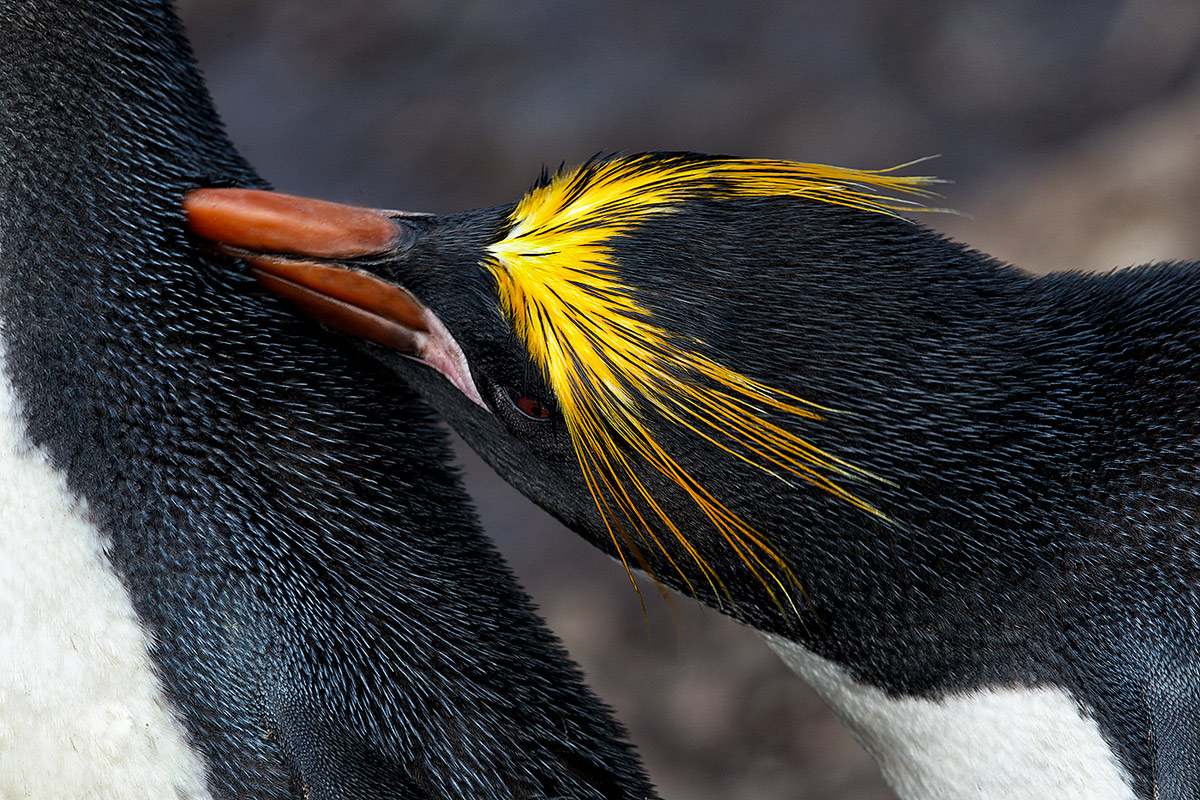
|
|
This Macaroni Penguin image was created at Hercules, Bay, South Georgia with the Gitzo 3532 LS carbon fiber tripod, Mongoose M3.6 head, the Canon EF 300mm f/2.8L IS II USM Telephoto Lens, the Canon 2x EF Extender III (Teleconverter), and the discontinued EOS-1D Mark IV (now replaced by the Canon EOS-1D X). ISO 400. Evaluative metering +1 2/3 stops: 1/125 sec. at f/16 in Manual mode. Central sensor/AI Servo Rear Focus AF and recompose. Click here if you missed the Rear Focus Tutorial. Be sure to click on the image to enjoy a larger version. |
How Sharp?
When Outdoor Photographer editor Rob Sheppard saw the TIFF file for the image above he remarked that it was one of the sharpest bird photographs that he had ever seen. Considering that it was created with the 2X teleconverter that is quite a compliment.
Speaking of Contests!
BIRDS AS ART 2nd International Bird Photography Competition
Only 11 days left to register and pay.
Big News
With so many folks signing up at the last minute and with so many folks having trouble uploading their images due to server overload, the deadline for entering the contest (registering and paying) has been extended until January 31, 2014. There will be no additional extensions. The deadline for uploading your images has been extended until midnight Eastern time on February 10, 2014. Take advantage of this extension to have a crack at the great prizes.
Learn more and enter the BIRDS AS ART 2nd International Bird Photography Competition here. Twenty-five great prizes including the $1000 Grand Prize and intense competition. Bring your best.
Register and Pay
To register click here.
To learn of payment options, click here.

|
|
This afternoon seminar is 100% free and open to the public. |
Free Afternoon Seminar
Join Denise Ippolito and me on the afternoon of January 28, 2014 at 1:00pm in the Boca Grande Community Center for a free two-part nature photography seminar entitled “Birds and Blooms.” At 1:00pm I will be presenting “A Bird Photographer’s Story” (updated with lots of my favorite new images). Denise will follow with her hugely popular “Bloomin’ Ideas.” The venue is located at 131 First Street West, Boca Grande, FL 33921.
Suggestion
Join us for the free seminar and then for the Venice Rookery IPT the following day.
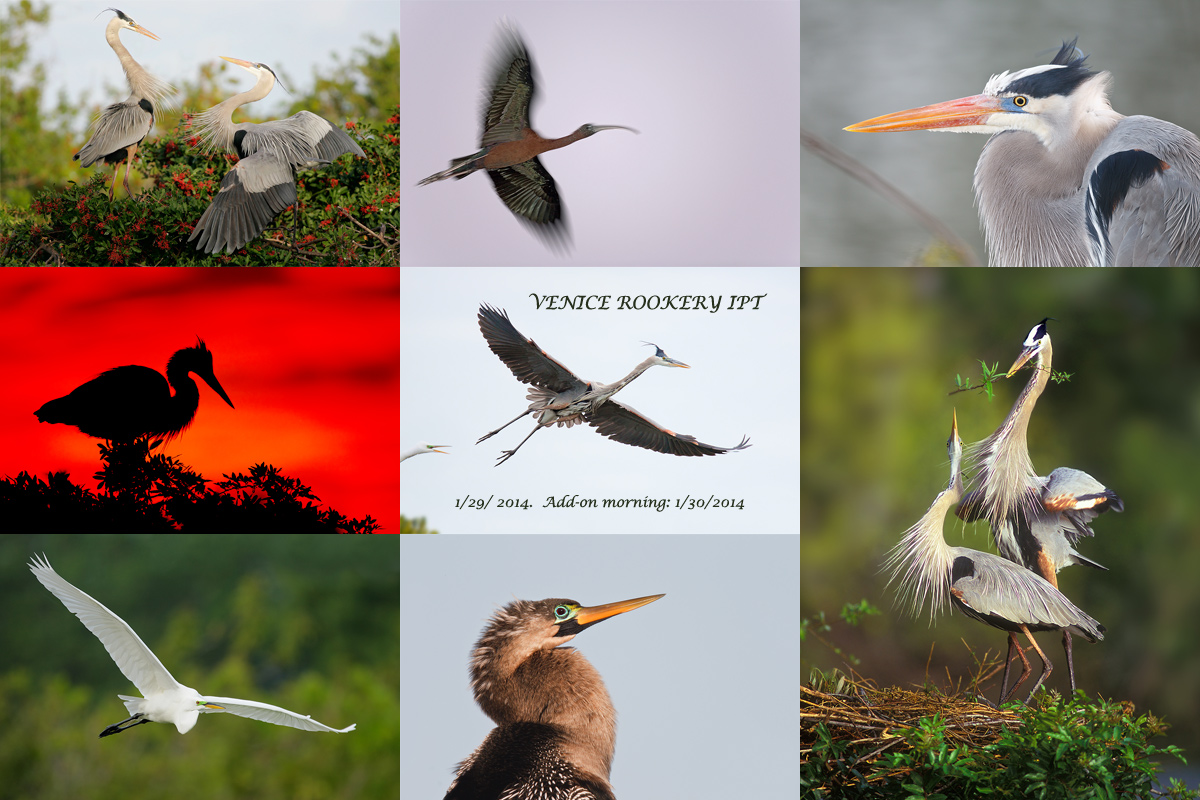
|
|
Do join us on the Venice Rookery IPT, or better yet, for the whole South Florida Composite IPT. Scroll down or click here for complete details. |
The 2014 South Florida Mini-IPTs
Because of our intense travel schedule that includes a trip to Japan I will not be running the traditional SW FLA IPT. In addition, in an effort to give some folks a chance to get a taste of our teaching and our passion for bird photography, Denise Ippolito and I have organized a series of short IPTs that may be combined into one wonderful experience or enjoyed piecemeal.
Jan 29 (WED): Venice Rookery In-the-Field: all day: (Limit 14/Openings 10): $399. Introductory slide program 7pm, Jan 28.
30 (THURS) -Venice am only. (Limit 14/Openings 10):: $249
You can sign up for one or more of the short IPTs and/or one or more of the add-on days or you can opt to sign up for the all the sessions. Those signing up for the whole shebang will be having all lunches and dinners with us most every day.
A $500 non-refundable deposit is required to hold your slot for this IPT. For the short segments that are less than $500 payment in full is due at the time of registration. Your balance is due 4 months before the date of the IPT and is also non-refundable. If the trip fills, we will be glad to apply a credit applicable to a future IPT for the full amount less a $100 processing fee. If we do not receive your check for the balance on or before the due date we will try to fill your spot from the waiting list. If your spot is filled, you will lose your deposit. If not, you can secure your spot by paying your balance. Best to call Jim or Jennifer with a credit card in hand to register. Credit cards are not accepted for balances. Alternatively you can send a check for $500 made out to Arthur Morris to us at PO Box 7245, Indian Lake Estates, FL, 33855. Please include a note with your e-mail address and be sure to let us know what you are signing up for.
Support the BAA Blog. Support the BAA Bulletins: Shop B&H here!
We want and need to keep providing you with the latest free information, photography and Photoshop lessons, and all manner of related information. Show your appreciation by making your purchases immediately after clicking on any of our B&H or Amazon Affiliate links in this blog post. Remember, B&H ain’t just photography!




Amazon
Everyone buys something from Amazon, be it a big lens or deodorant. Support the blog by starting your search by starting your search by clicking on the logo-link below. No purchase is too small to be appreciated; they all add up. Why make it a habit? Because I make it a habit of bringing you new images and information on an almost daily basis.
Typos
In all blog posts and Bulletins, feel free to e-mail or to leave a comment regarding any typos, wrong words, misspellings, omissions, or grammatical errors. Just be right. 🙂
IPT Info
Many of our great trips are filling up. See especially info on the South Florida, Holland, and Nickerson Beach IPTs. Two great leaders on most trips ensure that you will receive individual attention, have all of your questions answered, and learn a ton including how to think like a pro, see the situation, and get the right exposure every time. In addition you will have fun, and make lots of great images. Click here for IPT details and general information.

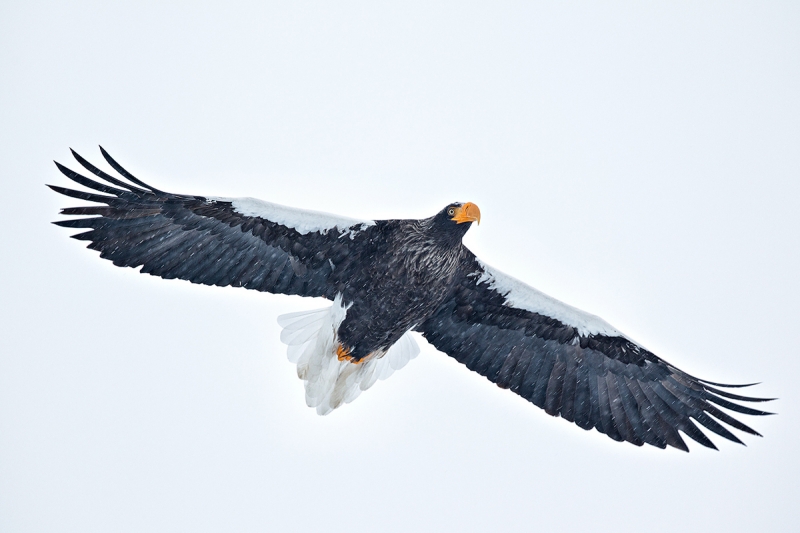
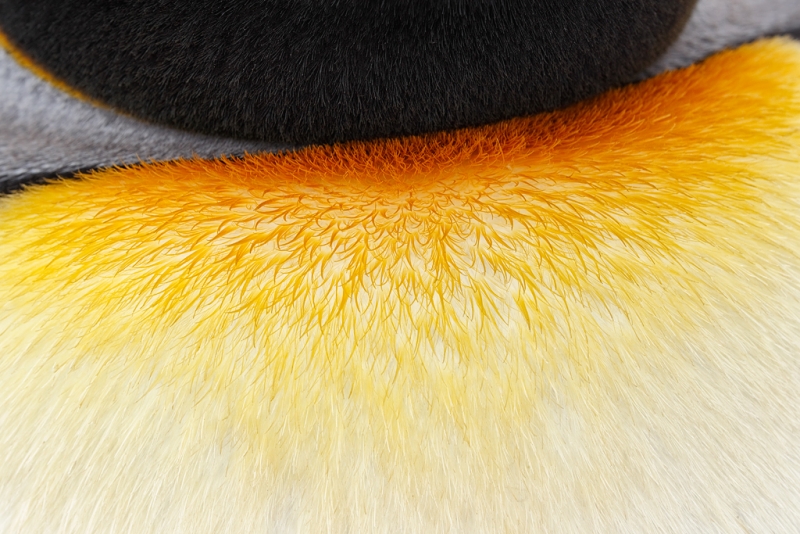















As a thank you for your many posts even when you are sick I ordered my Canon 6D through your B&H link. I hope you feel better soon.
Many thanks Pam. I slept a lot better last night but still feel basically like a pile of dung :). The way that I look at it being sick should make us appreciate how could we usually feel every day that we wake up.
In regards to the Pelican foot…maybe another alternative… clone the right foot and flip it to replace the dangling left…or maybe vice versa after repairing the left? The only reason why I bring that up is, it just looks kinda weird with one dangling.
Doug
Thanks Doug, I could not work from right foot to left or vice versa because the position and shape of the feet is so different… What can I say, one foot was dangling and the other was held higher up into the bird’s body…. artie
Artie: Spectacular images, especially of the macaroni penguin. Wow….Typo: It’s Steller’s, not Stellar’s, sea eagle (right under the heading “Japan”). You’ll be pleased to know I saw and photographed a snowy owl at Washington’s National Airport today. Not bad, you could almost tell it was an owl; it couldn’t have been more than 1/2 mile away… By the way, just how many contests, museums, and galleries are named after you? 🙂 Glad you’re up to “lousy” today.
Thanks. I teach people to spell that correctly–just a non-thinking brain typo. Thanks for the cold good wishes. artie